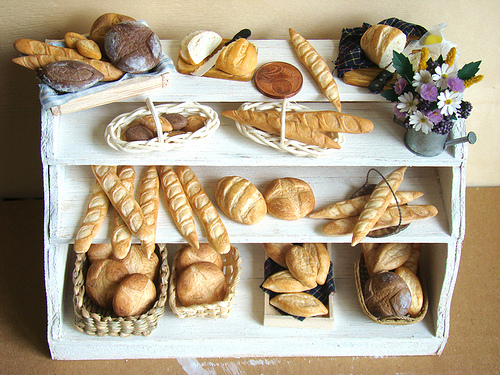Bread Storage: Do it Right

Author: eric
Bread is best after it is just baked and still warm. The moisture has evaporated, intensifying the flavor, creating a soft and creamy taste on the palate. Finding what to do with excess bread is often problematic to maintain its freshness. Therefore proper bread storage can be vital to maintaining delicious bread for days after creation.
Don’t store warm bread in plastic bags or plastic wrap. Wait until the bread has completely cooled down, to prevent condensation from forming in the bag. Condensation in the bag will accelerate mold development.
Lean, crusty breads are stored differently than soft enriched breads. If you want to preserve the crustiness in lean breads, store them in paper, but they will become stale within a day. It is best to eat the same day they are made. If you want to preserve them for more than a day, wrap the loaves in plastic wrap, preventing any air from getting to them. You can also use zipper-style plastic bags, squeezing out all the air before sealing. Either freeze or place them in a cool, dark place.
Avoid crusty bread storage in plastic bags or in plastic wrap unless you plan to re-crisp the crust in the oven following the previous reheating instructions. Do not store bread in the refrigerator. It dries out, even when packaged in sealed plastic bags.
Soft enriched bread, such as sandwich bread, are best stored in plastic, either frozen or kept in a cool, dark place. Exposing soft breads to sunlight causes the loaf to sweat, creating condensation in the wrapper leading to mold on the loaf. Bread storage by freezing pre-sliced sandwich loaves gives the option to remove only the slices you are planning to use. They also thaw quicker than whole loaves.
To thaw a frozen unsliced loaf, pull it from the freezer at least 2 hours before you need to use it. Trying to accelerate the thawing process by putting it into the oven or microwave can dry the bread out. If it is necessary to expedite bread thawing, place it under a wet towel, before placing into the microwave or in a hot oven. This method of bread storage is the most effective way to prevent it from drying out. For oven instructions, preheat to 400°F. Place the bread in a pan, covering it with a towel that has been soaked in warm water and then wrung out. Check on the towel every 10 minutes to see if it needs rewetting. It should take 20 to 30 minutes to thaw out a standard-sized loaf, 10 to 20 minutes for a baguette. In order to restore a crackly crust to the bread, remove the damp towel for the last few minutes of reheating, turning the oven up to 450°F.
When talking about bread crumbs or croutons, store soft enriched breads in paper bags and allow them to dry out. Do not store any bread that you intend to dry for crumbs in plastic bags or plastic wrap. If the moisture cannot escape, the bread will quickly mold.
There you have it guys. Just follow these guidelines for proper bread storage and you will be set.
Article Source: http://www.articlesbase.com/cooking-tips-articles/bread-storage-do-it-right-4200293.html
About the Author
For more information on Bread Storage and other topics related to brewad handling as well as to see high quality reviews of bread makers on the market, please visit our Bread Maker Review Site.













